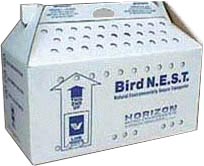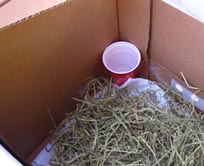|
Travelling with Ducks: People Who've Done It :::: Di and Davey McIlrath :::: Jen Jenner :::: Short Trip Tips :::: Transporting Ducks :::: Road Ducks Main Page Transporting Ducks Via Post Office or Airplane Certificate of Health In most, if not all states, a certificate of health from a licensed veterinarian is required before you can transport ducks via a postal service or overnight air carrrier. In California the certificate has to be issued within 10 days of the departure date. It is probably the same in other states, you can check with your duck vet or the service you will be using to transport your duck. Bio-Secure Containers We were required to use a bio-safe transport container for live birds. According to the website where we purchased ours: "These containers are designed to protect your birds, the birds sitting next to yours on the plane, the plane's cargo bay (environment) from diseases and viruses, postal machines and scales, and the postal workers themselves from the many highly contagious diseases carried by sick birds in transit."  
Postal Approved Bio-safe Carrier The carriers are designed for one use only, and have a water resistant lining and filtered air holes. We used the N.E.S.T. carrier (Natural Environmentally-Secure Transporter) from Horizon Micro-Environments. Be sure to read the regulations page and the "Do's and Don'ts" section. Gro-Gel To keep your duck hydrated during the trip, we recommend a substance called Gro-Gel Plus. We found it on the McMurray Hatchery website. You probably need only 2 packets per duck for the overnight flight. We followed the instructions and used a plastic disposable cup and taped it securely into the corners or the compartment so it wouldn't move around in transport. If you can't find Gro-Gel you can substitute with Oasis. Some Important Things to Know We learned the hard way that you must call the post office in advance and find out which airport the the birds will be flying out of. Arrange to deliver them to that hub at the airport yourself, do not trust your local postal carrier or office to deliver them in a timely manner. This can mean the difference between life and death of your pet. Our ducks went from our local post office to one airport, then the main airport. They do not transfer ducks from city to city on planes. Unlike people, ducks are required to travel on no more than ONE non-stop flight. The remaining transport is by truck. If you are not near a major airport, you will need to bring them there yourself rather than risk them being in transit too long. Ducks are Tracked Differently than Packages We were told to bring the ducks to our local post office and they would get them safely to the airport. We trusted them to do what they promised. What we found out later is that the tracking number they gave us at the local office was not the same as the actual tracking number the airport uses. Live Birds are handled differently than regular mail or cargo. They do not go into the same cargo hold with other species and can not travel in the same cargo hold as certain kinds of materials. Make sure the carrier is fully aware that you are shipping live birds. The box will be labeled, but some workers do not read labels. You don't want them in a holding area that may get very hot or cold. Using a permanent marker, write LIVE BIRDS on every side of the box that isn't already labeled as such. Make the Gro-Gel formula just before boxing the duck. It dries out in about 24 hours, and you want it to last as long as possible. You can also chop some watery veggies and fruits like watermelon and lettuce to help them stay hydrated. Feed them and make sure they drink as much as possible right before travel. 
Make the Box Safe and Cozy Line the bottom of the box with a soft towel or fleece. We carefully taped the corners down so they wouldn't be able to eat the tape. It gives them a foothold to keep them from skidding around inside the box and getting injured. A better way to do it would be to cover a piece of cardboard that's cut to fit the bottom, then place that on the bottom. We added some hay on top of the towel for extra padding. When to Ship It goes without saying that you will be shipping them priority overnight. Expect to pay $50.00 or more for the shipping, and another $50.00 or more for box and hydration supplies. Be sure to ship ducks at the beginning of the week, NEVER Thursday through Saturday when staff changes or goes home for the weekend and chances of a mix-up are much higher. Be absolutely sure that there is a recipient ready to act at a moment's notice as soon as the duck arrives. Most post offices will deliver them to a residence because it is a live duck. They will do a special delivery so the duck will not sit on the truck or in the hub all day. You should call ahead to make sure the local post office knows a duck will be arriving. The duck will need fresh water and food and a little exercise right away. Travel can be traumatic for a duck, so be sure to do this only when there is no other choice. Your best bet is transporting them yourself. So far, no airline I've talked to will allow ducks in a pet carrier in the main cabin. Many will allow them to travel in the cargo hold with other animals. They will need that certificate of health and a bio-safe container just the same. And there is a risk of being lost like so much of our luggage, so don't cut corners, do it right for the best chance of a safe trip! |